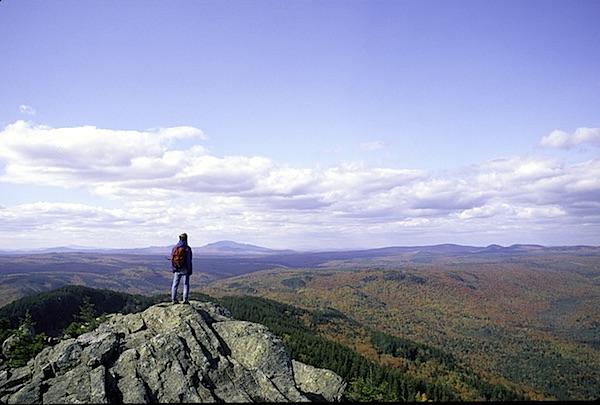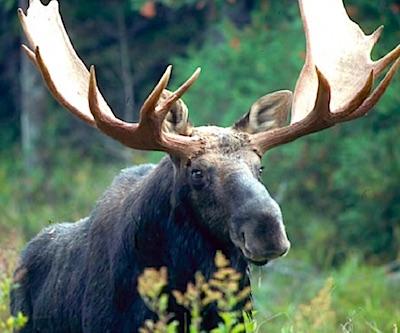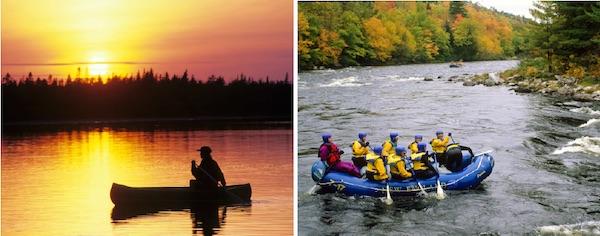
A hiker atop Borestone Mountain gazes into a potential national park in Maine/George Wuerthner
Maine isn't all rocky coastlines. Travel to the Pine Tree State's interior and you'll find a mythical, verdant, forested woodland of hemlock and balsam that inspired Henry David Thoreau's treatise, The Maine Woods.
"Every creature is better alive than dead, men and moose and pine trees, and he who understands it aright will rather preserve its life than destroy it," wrote Thoreau in expressing his concern for the future. "The mission of men there seems to be, like so many busy demons, to drive the forest out of the country.'
Under vast stands of ancient trees there are many shades of green, giant mushrooms, and mattress-soft patches of moss. The forest is so dense in places that just small shafts of sunshine penetrate and illuminate the ground, almost like spotlights. Occasionally, a moose will amble in and out of the timber, its domain embracing countless hidden lakes and streams that dot the woodlands.
The forest seems timeless.
But these woodlands have also been where families found their livelihoods for generations. They affectionately call it their 'wood basket,' where outdoorsmen, loggers, anglers, and hunters work and play. But now the woods are in conflict. Traditional users and preservationists debate the merits of a proposed national park and recreation area. The original national park proposal of the 1990s was huge; more than 3 million acres, nearly a third of Maine's Great North Woods. It envisioned one of the country's largest national parks, larger by almost a third than Yellowstone National Park. This plan was not well-received. Opponents were especially critical of millionairess Roxanne Quimby, who was donating 150,000 acres of her own lands towards a park.
Quimby is co-founder of Burt's Bees, whose honey-based lip balm and other personal care products made her a millionaire many times over. After selling the company, she has applied her wealth to conserve Maine landscapes.
But now a smaller plan is seeing more support from the locals. The current Katahdin Woods and Waters National Park and National Recreation Area proposal is just 5 percent as large as the first plan, would offer a blend of allowed activities and, according to proponents, involve less than 1 percent of the state's timber resources.
Just two hours from coastal Acadia National Park, the proposed park abuts Baxter State Park and has spectacular views of Mount Katahdin, the northern terminus of the Appalachian National Scenic Trail.
Quimby is prepared to donate 75,000 acres along the East Branch of the Penobscot River for the park, and another 75,000 acres for a national recreation area along its west bank. The national recreation area might help sooth local opinion as it could be open to hunting, fishing, and snowmobiling.
Quimby's son, Lucas St. Clair, has become its primary advocate. St. Clair is the president of Elliotsville Plantation Inc. (EPI), a company created to manage the land. (The entity's name comes from the unorganized township where Ms. Quimby first purchased lands with an eye on conservation.)

Maine's North Woods is a sanctuary for wildlife and wild lands dotted by lakes and threaded by rivers/George Wuerthner
St. Clair's grassroots approach has brought the boil back down to a simmer. He spends much of his time hunting and fishing in these very woods and discussing the proposal with proponents and opponents alike.
'We've been able to hear voices from people that are greatly affected by the outcome of this and we've been able to shape the proposal to meet the cultural and historical heritage of the region so that it really enhances what is here already as opposed to creating something that has never existed in the past,' he says.
Some opponents say the National Park Service can't manage what it already owns, and they are also wary of the federal government. During a park informational meeting in March, locals questioned the park's economics. Lincolnville resident and Friends of the Maine Woods member Andrew Young was quoted in the Bangor Daily News, as saying, 'The economic numbers do not make sense. This park will not happen. There is no money to make it happen.'
Against that view, however, St. Clair and his mother have pledged to raise a $40 million endowment for the proposed park; half would come from Ms. Quimby, and the other half from a matching campaign.
At the same time, hundreds of business owners have voiced support, saying a national park would be good for the economy as it would bolster the tourism sector and showcase a part of Maine that has been overshadowed by the state's coastal amenities and attractions.
While national park status is the nation's highest level of protection, the designation can carry some baggage. National parks may bring in tourism dollars, create jobs, and set high conservation standards, but they can also impose stricter environmental standards on surrounding industries, set restrictions on heavy recreational usage, and lure low-paying jobs.
And yet there's recognition that logging is no longer the economic stalwart it once was.
David Farmer, an EPI spokesman, concentrates upon the positive.
'It's not an either/or,' he says. 'We do not see this as competition. Industry and the national park can co-exist.'
Proponents, noting that Acadia is one of the country's top-ten visited parks, believe that a park in Maine's interior would further burnish the state's status as a tourism destination.
'An inland park would really complement the highly-toured coastline park,' says Farmer. 'This would allow tourists to move inland after a visit to Acadia for a more holistic look at the cultural, educational, and recreational experiences centered on Maine's woodland heritage.'
As mills close and young people move away in search of jobs, there's a growing sense that something needs to change for the state's economy.

From peaceful backcountry paddling destinations to thrilling whitewater adventures, Maine's North Woods offers an array of recreational opportunities/George Wuerthner
Gail Sanjoy, president of the Katahdin Chamber of Commerce, says, 'The proponents of the national park don't believe that the national park standing alone will be our area's savior, but it will go a long way from where we are today. We need to explore all options, and keep all options on the table, and the national park happens to be the offer on the table right now.'
In March the Bangor City Council voted 7-2 to support the concept of a national park, joining the towns of Millinocket, East Millinock, and the Penobscot Indian Nation. In late March, more than 200 Maine business owners sent a letter of support to their congressional delegation, which has not as yet supported the concept, choosing to listen to their constituents. But it's obvious that support is growing.
Proponents see the land and its endowment as an incredible gift at a time when economic options are limited, and feel something needs to be done. For others, these woods are their home, which contribute much more than hiking trails for the occasional tourist.
Miri Gubler spent the spring semester as an editorial intern with the Traveler. She previously has written about Acadia National Park and California condors



Comments
EC, you wanted an example and I provided it.
How things transpired after the NPS said 'no' I can't say, just as with more than 400 units of the park system, and who knows how many studies, I can't immediately point to any other examples where the agency opposed a designation.
But I'd wager that some NPS eyes rolled when Ohio Congressman Regula pushed through the legislation to create the First Ladies National Historic Site in his home state. And despite Dr. Runte's fondness for railroads, Steamtown is another head scratcher.
In Traveler's Call for Papers, you might recall that we raise the question of whether the Park Service is more and more turning into a catchall for places that might better be cared for by the states, or perhaps a National Historical Service. I think that's a good and timely question to ask as the agency approaches its centennial.
But really, do you expect the NPS to say "no" to many -- if any -- proposed additions? Their job is to manage what they're given, and while it'd be nice if their position on prospective units would be accepted by Congress, that's politically untenable. Rick Smith made that quite clear.
I don't see any irony in my position on Paterson Falls and Maine North Woods. You can't compare the two sites; apples and oranges.
There are very few places left in the country where large expanses of natural landscape can be added to the National Park System, unless you start transferring national forests or BLM landscapes. As the NPS said, many other sites already in the system interpret what Paterson Falls offers.
As for Salazar's comments, what's he going to say? "This is an atrocious addition that's been foisted on us, but somehow we'll manage."
Frankly, I think the Interior Department position in 2001 was one that needs to be echoed today with some force, damn the politics.
Just for the record, the Park Service has said "no" to scores of potential units, especially in the 1920s under Stephen T. Mather. The point is: He was a millionaire and didn't give a damn what Congress happened to "think." Under Mather, the National Parks Association (which he formed) attacked so-called inferior units. As president of NPA, Robert Sterling Yard was good at it, too.
The trouble is: Yard also attacked worthy eastern units, since they did not live up to the geology of the West. He didn't like Shenandoah, for example, although he begrudingly came to accept Great Smokies and the Everglades. Nor did the NPA properly defend Olympic National Park, preferring to axe the trees. Jackson Hole, in Yard's view, "borrowed" its grandeur from the Tetons. With Yard it was all geology, just as it remains today for many folks.
Meanwhile, Mather told the states flat out that it was their responsibility to preserve "local" scenery. Of course, Washington State would NEVER have done with that the Olympic rain forests; its own congressional delegation was also opposed. Nor would Wyoming have spared Jackson Hole. Arizona would have dammed the Grand Canyon, no matter what the nation thought.
The issue before us with 407 units is a throwback to our past. As a country, we have never properly funded the national park system--never, never, never. Even when it was one unit--Yellowstone--Congress waited five years to fund it. In the end, the railroads wound up funding the parks, that is, developing them for tourist travel.
We always prefer the "fix." We'll "raise" the money from "outside." We'll find another Rockefeller, or a couple hundred Rockefellers. If not, we'll raise the fees at the gate. Why do we do this? Because we are broke, and always have been broke. We just don't admit it. We just keep issuing bonds in hopes that no one calls them "junk."
Today, according to THE WALL STREET JOURNAL, your government and mine is backing the bankie wankies to the tune of 26 TRILLION. Yes, TRILLION. And you want parks? Ha! Get to the end of the line--way to the end of the line. The very back of the line. There is no one in back of you. Everyone with a hand out is ahead of you, starting with the banks.
This is what Harry Butowsky has been trying to say. As for the Park Service not saying "no" enough, how do you say no to people who only know how to say yes? Congress just can't say no. The American people themselves don't want to hear it. In that case, we can hardly expect the Park Service to be immune, although yes, I think it is still reasonable to ask that they take the high ground and allow Congress to push them off the cliff. In the end, history will tell who did the pushing--just in case anyone at the back of the line really cares.
So, you can't say whether a park was in fact established over the NPS objection. The point here (Alfred) is not whether the NPS ever said no its whether it ever said no and had a park established anyway. The original complaint was that Congress was establishing parks and not funding them. My point was that NPS was happy to get these new parks despite their lack of funding.
A total mischaracterization of the issue. They aren't backing the banks the are backing your pensions, your deposits and your mortgages and are taking insurance payments to cover any losses. But I agree, the government should get out of the "guaranteeing" business.
Actually, the Park Service said "no" to Olympic National Park--and got it anyway. Nor were they "happy" to have it. Read Carsten Lien's book, OLYMPIC BATTLEGROUND.
Obviously, directors (and policies) come and go. But in general, Park Service employees have always "prioritized" the system, much like the faculty in universities. You don't want to move to a "career-ending" park. You rather want to stay in the Ivy League. That is probably the best indication, between the lines, of what the Park Service wanted and didn't want.
Do you say "no" in a Congressional hearing? Never. But directors often plead their case to the Secretary of the Interior. Remember. The Park Service director does have a boss. As boss, the President--through the Interior Secretary--determines what the agency will "want"--and not want. By the time Congress holds a hearing, the director has his marching orders. And they do not include embarassing the president in public. All of that discussion goes on behind the scenes.
As I said to retired Park Service Russ Dickerson years ago in response to his quip: "Why should I fall on my sword?" "Russ, I don' expect you to fall on your sword, but yes, I would like to see you flash it once in a while." In this administration--or any administration--we need to concede how difficult that is.
Some excellent observations by Dr. Runte. Unfortunately, he's right.
Thank you, Traveler, for the article to update us on the proposal I've been following for 25 years and to all the commenters for an excellent discussion.
Exactly right, Ron. And the two books you mention should be required reading for all of us who frequent Traveler.